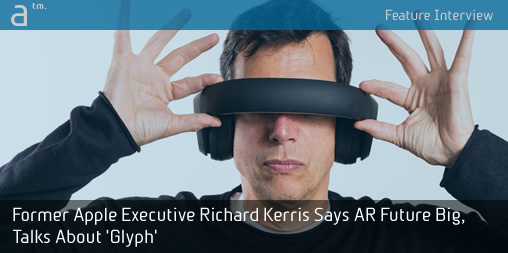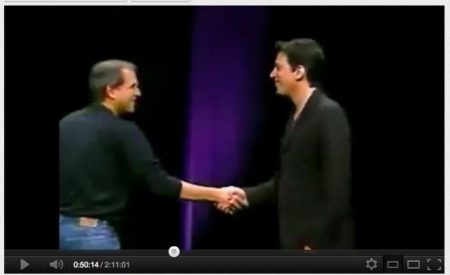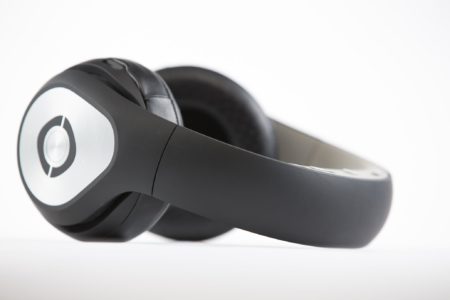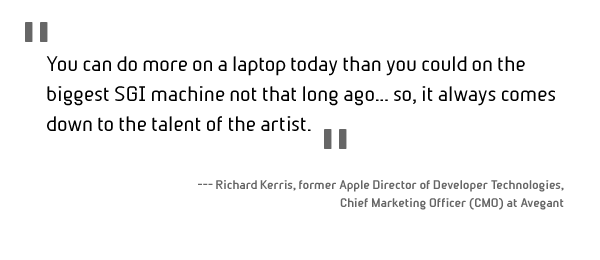A lot of you may recall that Maya, Shake, and other powerful 2D and 3D applications surfaced during Richard Kerris’ tenure at Apple—giving many Mac users access to Pro applications they never had before. This was a big and exciting time for the Mac faithful… and so much of it due to Kerris’ work.
Yet Kerris’ resume extends far beyond his key work at Apple; Richard is a proven leader in both new startups and established companies’ business units. He has over 25 years of in-depth experience in the areas of product development, eco-systems, development, marketing and sales of computer graphics, video & audio production technologies, and mobile apps. He even spent some time working with The Rolling Stones, as a technical advisor on their ‘50 & Counting’ tour.
While he has held executive positions at Nokia, HP and Apple, one of his most prominent roles after Cupertino was that of Chief Technology Officer at Lucasfilm (from 2007 – 2011) where he oversaw the company’s global technical operations, and was responsible for management and execution of the technology strategy for Industrial, Light & Magic (ILM), Skywalker Sound and LucasArts. He’s had a long prosperous career that has impacted many creative pros from their apps to their hardware… and he shows no signs of slowing down.
Avegant and The Glyph
Today, Richard is CMO at the startup company, Avegant, a company creating technology based on retinal imaging and projection. Their first product is called ‘The Glyph’, which began shipping earlier this year. (image 01)
Avegant is a company that wants to recreate how we see things by capturing natural perception with such clarity there is not a disconnect between you and the technology you are using, be it media, VR or AR. The Glyph is a revolutionary first product that gives you the feeling of having the best seat in the movie theater, with complete mobility and amazing visual quality.
With so much going on in VR and AR in the markets, and knowing of his important new role at Avegant, I reached out to reconnect with Richard to have a conversation about some of the topics in our market today and to better understand some of the things he’s been working on as of late… and what we might see in the near future. No easy task, he stays busy… as a passionate creative himself making music, producing videos and has an extensive photography portfolio. (www.richardkerrisphotography.com).
The Interview
Hi Richard, how have you been?
Hi Akiko, it’s great to hear from you, I’ve been busy…as usual.
Richard, can you tell us a little bit about your work at companies like Pixar, Apple, ILM, Nokia and Avegant?
My career has been primarily focused on the marketing side of computer graphics, developer eco systems, mobile and now VR/AR technologies. I also had the technical management aspect as CTO for Lucasfilm, which was one of the highlights of my life. Now I’m back on the marketing side as CMO for Avegant, but the experiences of these past roles have all played a significant part in helping me do my job today.
Avegant is a company on the forefront of wearable technologies for media. I enjoy working to bridge the gap between engineering and marketing, from both internal companies and external with developers. Early on in my career I was mentored by some amazing people who helped me understand the best way to expand your horizons is to broaden your reach, don’t keep doing the same thing over and over… reach out, learn, fail forward when you have to… but don’t be stagnant and always be willing to explore something new and different, especially if it challenges you.
Do you think VR (virtual reality) will be the future?
I don’t think VR will be as big as a lot of people seem to think it will be, I think Augmented Reality (AR) will have a much larger and more practical role.
There’s a few inherent problems with VR, the biggest one being that in order to really experience it, you shut out your natural surroundings, requiring you to submit to being ‘all in’ in order to fully engage in that experience. And while that experience, when done well, can be absolutely amazing, it’s not ideal for the long-term use. It can be disorienting and in some cases make you a bit nauseous after long periods of time using it. AR is broader and will be bigger because it combines what you see and experience around you, while mixing in the CG elements to create an entirely new way to experience content.
I suggest you watch some of the YouTube videos from Magic Leap, Osterhout Design Group, Microsoft and Meta, which show some of the results of mixing synthetic and real elements for entertainment and data visualization through wearing glasses and viewing the world around you. There will be a much larger market for this kind of technology—even though right now it’s either not yet available or it’s cost-prohibitive for the majority of people… but like the big clunky cellphones in the 80s gave way to the ones in our pocket today, AR technology and feasibility will drastically improve. It’s coming… and I think it’s going to dwarf what is VR, as we know it today.
What type of hardware do you think will drive the development of VR and AR?
Your phone is a computer—increased speeds to the ‘cloud’ connects you to whatever you need to access—that’s the core. The challenge is the ‘faceware’, or the glasses, helmet, visor you need to wear.
Right now, some companies have devices that are a mix of a visor, heavy glasses and or a helmet (yuk!)…when you wear them the experience is pretty good…but, would you wear them for a long period of time? Like a few hours? No…not in that configuration. I think that’s not practical or comfortable. These devices become hot, heavy, and bulky…but imagine when this technology has advanced to the point of being as comfortable as putting on a pair of sunglasses because that’s coming soon.
Do you think the future of high intensity computing will be in the Cloud? Is this safe or are there security issues to explore?
Necessity and convenience will undoubtedly continue to bring all forms of computing to the cloud. Accessing your tools from anywhere and always having access to the best and fastest will continue to drive that.
Why buy the big bulky hardware when you can just rent it when you need it, from anywhere? Security will always be an issue, nothing new there just more ways for hackers to connect. So the security is always going to be an issue, you just have to be better than or stay ahead of the hackers. Better yet, hire the hackers, they know how best to protect you.
Do you think the business of selling PC’s has shifted from the desktop to the data centers that support apps for both iPhone & Android?
Yes, I think the whole model is turned upside down from where it was 20 years ago. Creative Cloud from Adobe is a great example of buying a subscription and having access to all their tools when you need and how you use them.
Switch machines, just log in to the cloud and you’re ready to go. It’s the same with apps for the phones and mobile devices… get a new phone, login and sync… and everything the way it was.
Do you think future content development will be driven by the VR/AR market? How important is content to VR and AR?
Content continues to come in many flavors. The narrative, like movies and TV, will continue because most people like to have a time to just kick back, be passive, and watch a story being delivered to them. VR is more about the active experience, not passive…get in that world and explore… and AR, as I said earlier, is mixing it all up. So, just like you have movies and games ongoing, these emerging mediums will have content developed for them specifically. I think it’s incredibly important that the content developed for these new mediums be compelling and interesting.
That’s one of the biggest challenges I see in the VR space today; most of the content I’ve experienced is pretty bad.
How would you say the Creative Pro’s role has changed in the past few years and where do you see their future role?
I think the biggest change is the availability of very powerful software tools and much lower cost machines to run them.
You can do more on a laptop today than you could on the biggest SGI machine not that long ago… so, it always comes down to the talent of the artist. That will continue to be the main guiding principal… it’s never about the machines, it’s always about the talent driving them.
Can you tell us about your new device the ‘Glyph” and how it works?
The Glyph is what we call ‘Mediawear’—that is a new category of personal media device that you can take with you, it’s used for experiencing your content off your phone, computer or tablet, anywhere through a pair of ‘headphones for the eyes’.
This first product is not exactly VR, but yet it’s immersive as it supports 2D, 3D and 360-degree content. We use our patented technology called ‘Retinal Projection’ which doesn’t have a screen attached to your face, but instead uses 2 million micro mirror’s to safely project images directly onto your retina, providing a crystal clear picture from just about any HDMI source.
The Glyph is our first product using this technology; we think there’s a long way to go with it.
Who do you think will be early adopters of the ‘Glyph’?
The three main areas for our product have been frequent travelers, drone enthusiasts and gamers.
The next time you’re on a long flight, imagine your headphones become a personal movie theater and you can watch whatever you want, or even do computer work in complete privacy from the person in the seat next to you.
Advertisement
Or when you’re out flying a drone, think about having access to see what the camera on the drone sees, with complete tracking by moving your head and yet when you look down you can still see your hands on the control.
Lastly, try playing any game on your mobile or desktop machine, but with an immersive crystal clear 3D experience without losing your awareness of the world around you. These are the main areas, but we’re always thrilled to see where customers and developers are taking it next—we just released an SDK for the Glyph, so there’s a lot more to come.
What have your learned from Steve Jobs that has been beneficial for your career?
You can always do better, don’t be complacent.
Are you playing Pokémon Go and if so how many Pokémon have you caught?
Not playing… just avoiding the players when I’m riding my bike is adventure enough 😉
You can follow Richard on Twitter at @richardkerris










Reader Comments
[…] Source link […]
“The next time you’re on a long flight, imagine your headphones become a personal movie theater” @richardkerris https://t.co/ZGI6XBGi7j
I key thing Kerris says in this article is that AR (augmented reality) is more valuable than VR (virtual reality). We can already start to see this today with Trimble’s HoloLens SketchUp product and similar beta offerings. This article below makes a good read as to why:
https://www.technologyreview.com/s/602124/augmented-reality-could-speed-up-construction-projects/
I key thing Kerris says in this article is that AR (augmented reality) is more valuable than VR (virtual reality). We can already start to see this today with Trimble’s HoloLens SketchUp product and similar beta offerings. This article below makes a good read as to why:
https://www.technologyreview.com/s/602124/augmented-reality-could-speed-up-construction-projects/
RT @avegant: Avegant CMO @richardkerris talks with @architosh about the future of #AR and #VR. Read more: https://t.co/w6adzlkOnb https://t…
Avegant CMO @richardkerris talks with @architosh about the future of #AR and #VR. Read more: https://t.co/w6adzlkOnb https://t.co/QVXWk0DJYG
Avegant CMO @richardkerris talks with @architosh about the future of #AR and #VR. Read more: https://t.co/w6adzlkOnb https://t.co/QVXWk0DJYG
RT @avegant: Avegant CMO @richardkerris talks with @architosh about the future of #AR and #VR. Read more: https://t.co/w6adzlkOnb https://t…
RT @avegant: Avegant CMO @richardkerris talks with @architosh about the future of #AR and #VR. Read more: https://t.co/w6adzlkOnb https://t…
RT @avegant: Avegant CMO @richardkerris talks with @architosh about the future of #AR and #VR. Read more: https://t.co/w6adzlkOnb https://t…
“The next time you’re on a long flight, imagine your headphones become a personal movie theater” @richardkerris https://t.co/ZGI6XBGi7j
RT @avegant: Avegant CMO @richardkerris talks with @architosh about the future of #AR and #VR. Read more: https://t.co/w6adzlkOnb https://t…
RT @avegant: Avegant CMO @richardkerris talks with @architosh about the future of #AR and #VR. Read more: https://t.co/w6adzlkOnb https://t…
The Glyph sounds like a Godsend for those long drives or flights. We’ve come a long way since the days of counting cows in the back of my dad’s station wagon…
The Glyph sounds like a Godsend for those long drives or flights. We’ve come a long way since the days of counting cows in the back of my dad’s station wagon…
@ Christopher Bowes,
Yes, Glyph looks like best of Bose headphones + your private movie screen. Sweet!! #avegant #glyph
https://t.co/PxpKMEaqbz – Augmented Reality (AR) future looks big… says former Apple executive Richard Kerris https://t.co/xPin44DjCO
RT @architosh: https://t.co/PxpKMEaqbz – Augmented Reality (AR) future looks big… says former Apple executive Richard Kerris https://t.co…
@ Christopher Bowes,
Yes, Glyph looks like best of Bose headphones + your private movie screen. Sweet!! #avegant #glyph
https://t.co/PxpKMEaqbz – Augmented Reality (AR) future looks big… says former Apple executive Richard Kerris https://t.co/xPin44DjCO
Comments are closed.